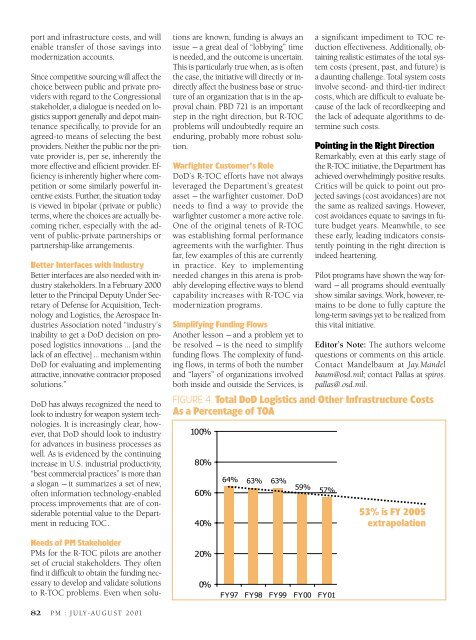Reducing Total Ownership Cost in DoD - Defense Acquisition ...
Reducing Total Ownership Cost in DoD - Defense Acquisition ...
Reducing Total Ownership Cost in DoD - Defense Acquisition ...
You also want an ePaper? Increase the reach of your titles
YUMPU automatically turns print PDFs into web optimized ePapers that Google loves.
port and <strong>in</strong>frastructure costs, and willenable transfer of those sav<strong>in</strong>gs <strong>in</strong>tomodernization accounts.S<strong>in</strong>ce competitive sourc<strong>in</strong>g will affect thechoice between public and private providerswith regard to the Congressionalstakeholder, a dialogue is needed on logisticssupport generally and depot ma<strong>in</strong>tenancespecifically, to provide for anagreed-to means of select<strong>in</strong>g the bestproviders. Neither the public nor the privateprovider is, per se, <strong>in</strong>herently themore effective and efficient provider. Efficiencyis <strong>in</strong>herently higher where competitionor some similarly powerful <strong>in</strong>centiveexists. Further, the situation todayis viewed <strong>in</strong> bipolar (private or public)terms, where the choices are actually becom<strong>in</strong>gricher, especially with the adventof public-private partnerships orpartnership-like arrangements.Better Interfaces with IndustryBetter <strong>in</strong>terfaces are also needed with <strong>in</strong>dustrystakeholders. In a February 2000letter to the Pr<strong>in</strong>cipal Deputy Under Secretaryof <strong>Defense</strong> for <strong>Acquisition</strong>, Technologyand Logistics, the Aerospace IndustriesAssociation noted “<strong>in</strong>dustry’s<strong>in</strong>ability to get a <strong>DoD</strong> decision on proposedlogistics <strong>in</strong>novations … [and thelack of an effective] … mechanism with<strong>in</strong><strong>DoD</strong> for evaluat<strong>in</strong>g and implement<strong>in</strong>gattractive, <strong>in</strong>novative contractor proposedsolutions.”<strong>DoD</strong> has always recognized the need tolook to <strong>in</strong>dustry for weapon system technologies.It is <strong>in</strong>creas<strong>in</strong>gly clear, however,that <strong>DoD</strong> should look to <strong>in</strong>dustryfor advances <strong>in</strong> bus<strong>in</strong>ess processes aswell. As is evidenced by the cont<strong>in</strong>u<strong>in</strong>g<strong>in</strong>crease <strong>in</strong> U.S. <strong>in</strong>dustrial productivity,“best commercial practices” is more thana slogan — it summarizes a set of new,often <strong>in</strong>formation technology-enabledprocess improvements that are of considerablepotential value to the Department<strong>in</strong> reduc<strong>in</strong>g TOC.Needs of PM StakeholderPMs for the R-TOC pilots are anotherset of crucial stakeholders. They oftenf<strong>in</strong>d it difficult to obta<strong>in</strong> the fund<strong>in</strong>g necessaryto develop and validate solutionsto R-TOC problems. Even when solutionsare known, fund<strong>in</strong>g is always anissue — a great deal of “lobby<strong>in</strong>g” timeis needed, and the outcome is uncerta<strong>in</strong>.This is particularly true when, as is oftenthe case, the <strong>in</strong>itiative will directly or <strong>in</strong>directlyaffect the bus<strong>in</strong>ess base or structureof an organization that is <strong>in</strong> the approvalcha<strong>in</strong>. PBD 721 is an importantstep <strong>in</strong> the right direction, but R-TOCproblems will undoubtedly require anendur<strong>in</strong>g, probably more robust solution.Warfighter Customer’s Role<strong>DoD</strong>’s R-TOC efforts have not alwaysleveraged the Department’s greatestasset — the warfighter customer. <strong>DoD</strong>needs to f<strong>in</strong>d a way to provide thewarfighter customer a more active role.One of the orig<strong>in</strong>al tenets of R-TOCwas establish<strong>in</strong>g formal performanceagreements with the warfighter. Thusfar, few examples of this are currently<strong>in</strong> practice. Key to implement<strong>in</strong>gneeded changes <strong>in</strong> this arena is probablydevelop<strong>in</strong>g effective ways to blendcapability <strong>in</strong>creases with R-TOC viamodernization programs.Simplify<strong>in</strong>g Fund<strong>in</strong>g FlowsAnother lesson — and a problem yet tobe resolved — is the need to simplifyfund<strong>in</strong>g flows. The complexity of fund<strong>in</strong>gflows, <strong>in</strong> terms of both the numberand “layers” of organizations <strong>in</strong>volvedboth <strong>in</strong>side and outside the Services, isa significant impediment to TOC reductioneffectiveness. Additionally, obta<strong>in</strong><strong>in</strong>grealistic estimates of the total systemcosts (present, past, and future) isa daunt<strong>in</strong>g challenge. <strong>Total</strong> system costs<strong>in</strong>volve second- and third-tier <strong>in</strong>directcosts, which are difficult to evaluate becauseof the lack of recordkeep<strong>in</strong>g andthe lack of adequate algorithms to determ<strong>in</strong>esuch costs.Po<strong>in</strong>t<strong>in</strong>g <strong>in</strong> the Right DirectionRemarkably, even at this early stage ofthe R-TOC <strong>in</strong>itiative, the Department hasachieved overwhelm<strong>in</strong>gly positive results.Critics will be quick to po<strong>in</strong>t out projectedsav<strong>in</strong>gs (cost avoidances) are notthe same as realized sav<strong>in</strong>gs. However,cost avoidances equate to sav<strong>in</strong>gs <strong>in</strong> futurebudget years. Meanwhile, to seethese early, lead<strong>in</strong>g <strong>in</strong>dicators consistentlypo<strong>in</strong>t<strong>in</strong>g <strong>in</strong> the right direction is<strong>in</strong>deed hearten<strong>in</strong>g.Pilot programs have shown the way forward— all programs should eventuallyshow similar sav<strong>in</strong>gs. Work, however, rema<strong>in</strong>sto be done to fully capture thelong-term sav<strong>in</strong>gs yet to be realized fromthis vital <strong>in</strong>itiative.Editor’s Note: The authors welcomequestions or comments on this article.Contact Mandelbaum at Jay.Mandelbaum@osd.mil; contact Pallas at spiros.pallas@.osd.mil.FIGURE 4. <strong>Total</strong> <strong>DoD</strong> Logistics and Other Infrastructure <strong>Cost</strong>sAs a Percentage of TOA100%80%60%40%64% 63% 63%59%57%53% is FY 2005extrapolation20%0%FY97 FY98 FY99 FY00 FY0182PM : JULY-AUGUST 2001
















